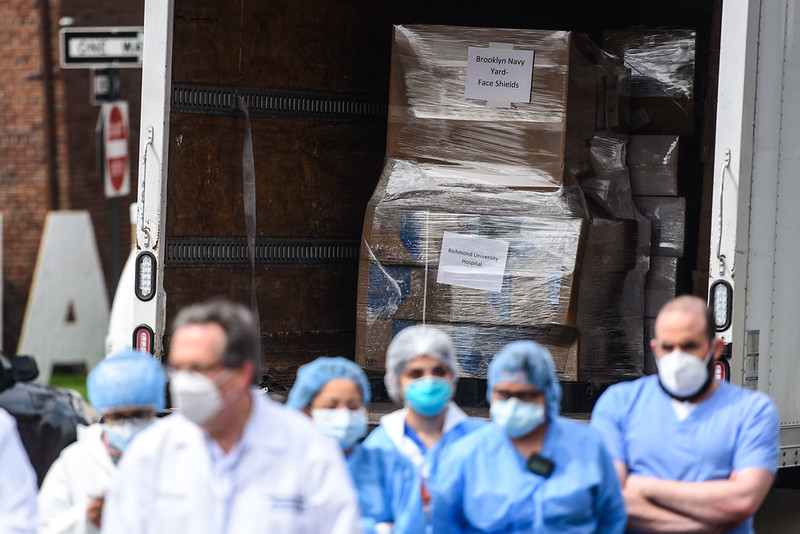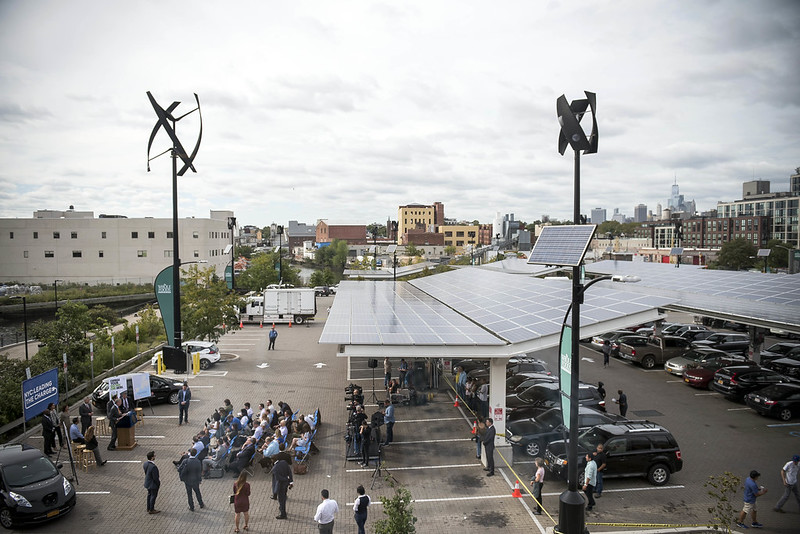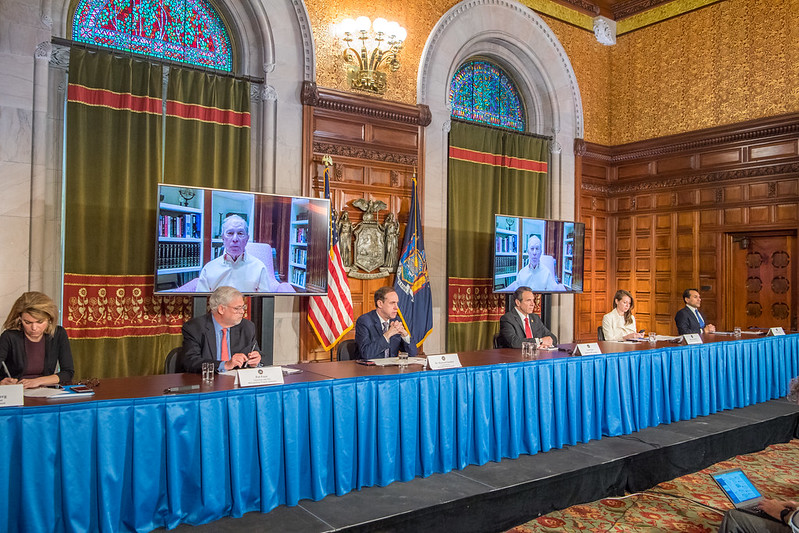From the Front Lines: A Respiratory Therapist’s Plea for the Next COVID-19 Package

A frontline health-care worker on what's needed next from DC (photo: Michael Appleton/Mayor's Office)
It has been a challenging, frightening time for everyone, but especially for those of us working in health care. Amid all the suffering and anxiety brought about by COVID-19, health-care workers on the frontlines have continued to show up and display strength, faith, and courage in taking care of the most vulnerable.
During these difficult times, I have never seen such dedication displayed by my co-workers in health-care facilities across New York City and throughout the state. At times overwhelmed, emotional, and exhausted as the surge of the virus engulfed us, I’ve never regretted the career path I have chosen.
In 1997, I migrated from Trinidad to New York City and pursued a career in health care as a Respiratory Therapist. During my 18 years as a therapist, I have intubated and managed countless patients on a ventilator at my hospital in Brooklyn. But all of my education and experience has been tested by the challenge of this pandemic.
On a daily basis my co-workers and I experience a massive influx of critically ill patients, each exhibiting new and unexplained symptoms. Brooklyn has had more than 50,000 cases of COVID-19 alone. Additionally, we are all managing the daunting task of caring for our own families and co-workers who are threatened by COVID-19.
The people at my hospital and medical professionals around the state – many of whom, like me, are proud members of 1199SEIU – are committed to delivering the same high standard of quality health care, regardless of this outbreak. But to do that, we need every piece of our health-care delivery system doing its part: health-care workers, health-care facilities, health insurers, our community, and state and federal government.
The heartfelt thanks and gratitude we have received from our communities – including the nightly rounds of applause – have been overwhelming and are greatly appreciated. But these words cannot save lives. To provide the needed care at this critical and challenging moment, my frontline colleagues and I need help. In particular, we need the federal government to provide the financial assistance that my co-workers, our patients, and our state need to deliver quality health care.
As they continue to discuss the next stimulus package, Congress and President Trump need to do the following:
Personal Protective Equipment (PPE): Whether they’re working in a hospital, clinic, nursing home or delivering home care, all frontline workers must have enough personal protective equipment (PPE) to keep themselves – and their patients – safe. It’s frustrating for me and my colleagues that Congress could ever think this is up for debate. We can’t deliver great care if we can’t protect ourselves from the diseases we’re fighting each day.
Crisis Pay: Frontline healthcare workers who are risking their lives every day they go to work should receive some sort of premium pay that recognizes their courage and the sacrifices they make day in and day out.
And as offices and schools alike are closed, many parents are juggling working from home while caring for their children. This is no doubt a challenging task. But for parents like me and many of those I work with, working from home is not an option, and the unexpected costs of finding daycare for our children have added a financial burden to the physical and emotional burdens we’re undergoing.
Medicaid Funding: Medicaid covers a third of New Yorkers, including millions of children and seniors. As the pandemic continues and unemployment skyrockets, more and more New Yorkers need that coverage. Our Medicaid program is already stretched to the limit and is about to break unless the federal government does its part and provides more funding for this critical program. If our hospitals don’t survive, our patients don’t. Medicaid funding is essential for us to continue doing the work we’re doing to battle this crisis.
In recent days, we have begun to see the light at the end of this tunnel. But our work is far from done.
The next COVID-19 relief package is being negotiated on Capitol Hill right now and must address the lack of resources across New York. If we get the support we need and deserve from Congress and the Trump administration, together we will win this health-care battle. We, as frontline health-care workers, are committed to do our job. Congress and the President have to do theirs.
***
Allison Trubett has worked as a respiratory therapist in Brooklyn for 18 years. She is a member of 1199SEIU United Healthcare Workers East.
***
Have an op-ed idea or submission for Gotham Gazette? Email This email address is being protected from spambots. You need JavaScript enabled to view it.
Carbon Free Is How We Build Back From COVID-19

Is the post-coronavirus future renewable? (photo: Ed Reed/Mayor's Office)
There have been many hard-learned lessons from COVID-19, but by far the most tragic – paid for with the lives of tens of thousands of people – is that when it comes to dealing with a public health crisis, preparation and proactive planning is the only approach that can keep our worst nightmares from becoming a reality. While New York is still far from reaching the light at the end of the tunnel, many inside and outside of government have rightly begun to envision what a restart to our economy should look like.
It is in this conversation that we have a unique opportunity to get the restart right by appropriately investing in a cleaner, greener, and more energy-resilient economy that will have the dual benefit of driving much-needed job and economic growth statewide while also helping fortify our defense against the next impending crisis for which there can be no vaccine – that of climate change and its impacts. By ensuring that governments like New York State make our long-term climate change goals a priority as part of the economy-wide restart, we can meet our immediate economic and public health concerns, as well as better position our renewable and clean energy industry to reach our broader climate change goals.
While the public health concerns and dangers of coronavirus are very serious and science should be the determining guide for any economic recovery plans, we shouldn’t lose sight of the climate crisis and how these goals are inextricably linked. New York residents are clearly being harmed by a changing climate caused by carbon emissions, with unequal impacts on the state’s most vulnerable and disadvantaged communities. By starting anew with a clean energy economy, we can expect to greatly reduce the risk of the increasingly serious effects of climate change.
The evidence of New York’s changing climate are readily apparent across every region of the state: a 74% increase in extreme precipitation since the 1950s; an increase in extreme storms like superstorm Sandy, which cost $40 billion in reconstruction and tourism losses; extreme drought in the Finger Lakes; flooding along Lake Ontario’s shoreline; and overwintering pests destroying our forests and crops. Sea level rise is also impairing coastal communities and infrastructure such as airports and sewage treatment plants. Flooding disrupts communities, agriculture, and water quality. New York State’s temperature has increased 2.6 degrees Fahrenheit since 1897. Action is clearly warranted.
Unfortunately, the federal government has abdicated its responsibility to protect the environment; a recent New York Times analysis found that of more than 90 environmental rules and regulations rolled back under the Trump Administration during the last three years, 16 concerned air pollution and emissions.
Without sufficient action at the national level to enact any kind of impact solution to climate change, like a national carbon fee and dividend, it’s up to each state to implement clean energy policies. Governor Cuomo has thoughtfully proposed a gradual approach to reopening the economy, with lower risk activities beginning before others and the private sector doing its part by adjusting to minimize the risk of spreading the coronavirus. That same logic – with New York seeking to implement its own plan irrespective of federal inaction – can and should be applied to investing in carbon-free policies that can help restart our “clean” economy in a safe manner while also advancing climate crisis goals.
New York has always been a national leader in fighting the climate crisis. Last summer, the state enacted the Climate Leadership and Community Protection Act, a historic climate law that calls for 70 percent of the state’s electricity to come from renewable energy by 2030 and 100 percent of the state’s electricity supply to be emissions-free by 2040.
In an effort to reach those goals, the New York Independent System Operator (NYISO) has proposed a carbon-pricing plan. Nearly all leading economists agree that carbon pricing -- which puts a price on carbon emissions to disincentivize such pollution and fund clean energy projects -- is the most efficient single step we can take to significantly reduce greenhouse gas emissions. Furthermore, it costs the government virtually nothing, hits nearly every sector of the economy, and protects consumers from rising energy costs.
Citizens’ Climate Lobby New York (CCLNY), a nonprofit, nonpartisan, grassroots advocacy organization and member of the Carbon Free New York coalition, fully endorses the NYISO carbon pricing plan. If enacted, the plan will reduce carbon emissions in the electricity sector by 22 percent and generate up to $691 million in annual economic benefits by 2025.
According to a report by the Alliance for Clean Energy, the NYISO plan will not only accelerate the pace at which the state moves towards its goals for 2030 and 2040 laid out in the Climate Leadership and Community Protection Act, but it will also demonstrate to the world New York’s ability to integrate aggressive environmental goals with a competitive market structure. And it will amplify the renewable energy industry, reducing pollution in a densely populated area, while positively impacting public health outcomes – goals that have become even more important to our recovery from the COVID-19 crisis.
For a safer and healthier New York, we must be carbon free.
***
Lynn Meyer is New York State Co-coordinator for Citizens' Climate Lobby (CCLNY), an international nonpartisan volunteer organization that advocates for federal carbon fee and dividend legislation and a member of the CarbonFreeNY coalition.
***
Have an op-ed idea or submission for Gotham Gazette? Email This email address is being protected from spambots. You need JavaScript enabled to view it.
Surveillance and the City: Public Trust Needed for a Public Tracing System

Bloomberg and Cuomo team up on contact tracing (photo: Darren McGee/Governor's Office)
The scene sounds familiar: Michael Bloomberg overseeing thousands of officials tracking where New Yorkers go and who they spend time with, all in the name of keeping us safe. In 2010, it was then-Mayor Bloomberg overseeing tens-of-thousands of NYPD officers as they stopped and frisked New Yorkers of color and spied on Muslim student groups and mosques. In 2020, it’s Bloomberg the philanthropist, helping to run the unprecedented effort to contact-trace the spread of COVID-19.
There’s a lot we don’t know about the state’s contact-tracing partnership with Bloomberg: who will have access to the data, how will data be kept, when (if ever) can data be shared with police. But there is a lot we do know about Bloomberg, facts that should give us pause about entrusting the most important public health effort in generations to the man who thought American Samoa’s presidential delegates were worth nearly $200 million.
Throughout his time as Mayor and short-lived presidential run, Bloomberg was a self-proclaimed stats guy, the man famous for saying: “In God we trust, all else bring data.” But for Bloomberg, data has a dangerous way of showing him what he already believes. Bloomberg views statistics with a Wall Street hubris, the mindset of the financial titans who assure us that they know exactly how to manage risk up until the moment everything crashes and they ask for the next bailout.
The truth is that data about human beings is almost inevitably biased, warped by countless subjective decisions that go into creating the data set. In finance, it was the logic of redlining that decided black homeowners were too risky to lend to, thereby depriving them of loans, and creating the self-fulfilling prophecy where many capital-starved black neighborhoods then saw higher rates of foreclosure after they were forced to turn to predatory lenders. It was the logic of stop-and-frisk, the racist policing practice that Bloomberg defended until the precipice of his presidential campaign, claiming “we put all the cops in minority neighborhoods. Yes, that’s true. Why do we do it? Because that’s where all the crime is.”
The problem is that communities of color weren’t the only place that “crime was,” it was just the only place where many laws were enforced. Looking back at my own lower Manhattan childhood, the reality is stark. Whether it was open container violations, drug possession, or other low-level offenses, we had these in abundance in wealthy white neighborhoods. The only difference is that no one was stopped for them, and thus the crime data showed they weren’t happening.
History is why so many New Yorkers want safeguards and answers before the Bloomberg partnership goes forward. At a time when the cash-strapped state is digging beneath the proverbial couch cushions for every spare penny, having Bloomberg finance the tracking program will come as a financial relief. But for contact tracing to be effective, Albany will need something more elusive than even Bloomberg’s billions: public trust.
Without public trust, without our willingness to hand over the most intimate details of our lives to a complete stranger, contact tracing will hit a dead end. Our ability to track disease is only as strong as the public’s ability to help. But rather than bending over backwards to reassure New York’s most vulnerable and potentially reluctant residents, the state’s leaders are dismissing the concerns out of hand.
When Public Advocate Jumaane Williams sent a letter to Governor Cuomo, asking for reassurances about Bloomberg’s role in the tracking program, the response was less than receptive. Rather than giving the city’s top civil rights watchdog the details requested, Cuomo’s spokesperson dodged most of his requests before saying “There’s enough real problems fighting this pandemic, and we have no time for politicians who create fake ones in a craven attempt to get in the paper.”
But that’s precisely the problem: privacy is already a part of the fight against the pandemic. If the Governor can’t give a clear and direct response to questions like, “who has access to the data,” then how can New Yorkers be expected to provide that data in the first place?
Throughout the COVID crisis, the Governor has doubled down on his impulse to act unilaterally. Some of those decisions have helped safeguard the state, but others have likely cost us lives and wasted millions (if not billions) in public funds. But this is a part of the COVID battle that Cuomo can’t fight on his own. A trusted, inclusive, culturally-competent contact-tracing system will require unprecedented public support.
If we go forward with Bloomberg at the center of the effort, then it will put even more pressure on state leaders to win the public’s trust. If we disclose all the details possible, create the strongest privacy safeguards in the country, and have a sustained public engagement campaign, then this might all just work. But if we don’t act now to prove to the public why this scheme is safe, then not even Bloomberg’s checkbook will be enough to erase his checkered privacy past.
***
Albert Fox Cahn is the executive director of The Surveillance Technology Oversight Project at the Urban Justice Center, a New York-based civil rights and privacy organization. He writes the monthly "Surveillance and the City" column for Gotham Gazette. On Twitter @FoxCahn.
***
Have an op-ed idea or submission for Gotham Gazette? Email This email address is being protected from spambots. You need JavaScript enabled to view it.




